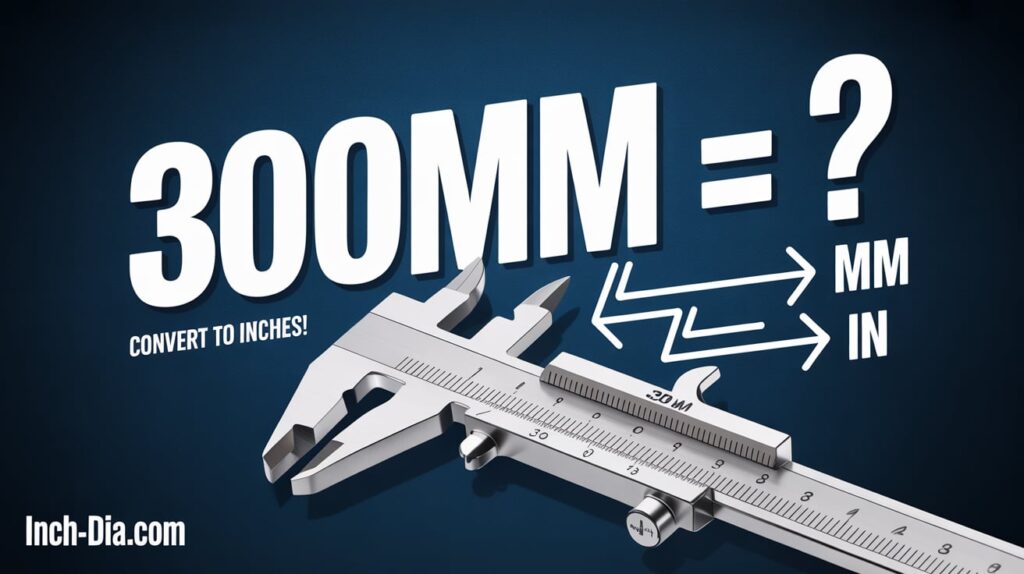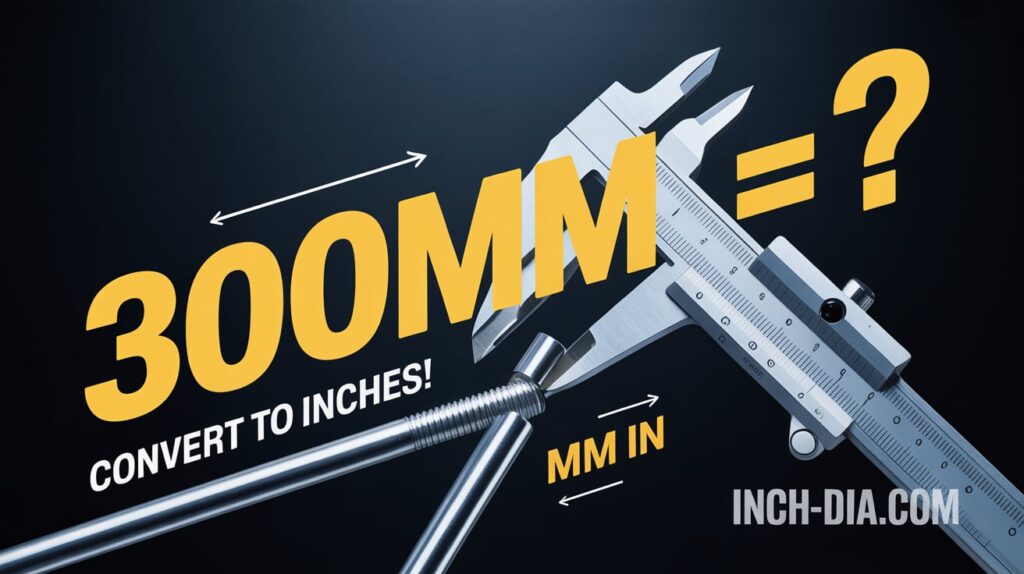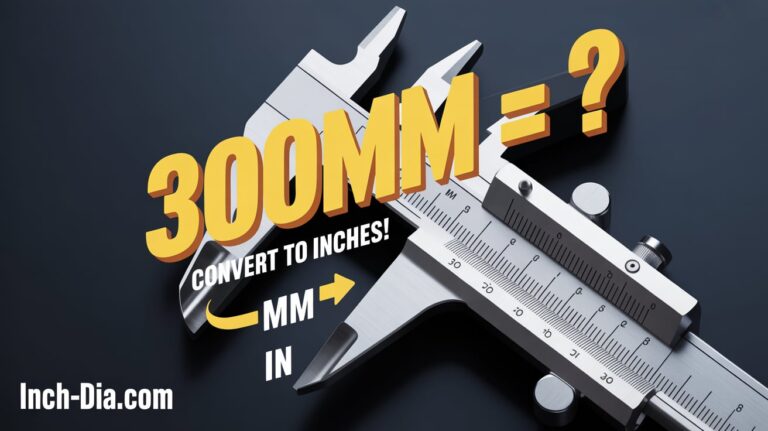Whether you’re tackling a home renovation, designing a piece of furniture, or working on a technical project, knowing how to convert 300mm to inches can save you time and prevent costly mistakes.
The metric and imperial systems often clash in today’s globalized world, and understanding how to navigate between them is a valuable skill.
In this comprehensive guide, we’ll break down the process of 300mm to inches conversion, provide practical tips, and explore real-world applications to make your measurements seamless.
By the end, you’ll be confident in converting millimeters to inches and applying this knowledge in various scenarios.
Understanding Millimeters and Inches
Before we dive into the mechanics of metric to imperial conversion, let’s take a moment to understand the units we’re working with. Knowing the basics of millimeters and inches sets the foundation for accurate conversions.

What is a Millimeter?
A millimeter (mm) is a small unit of length in the metric system, equal to one-thousandth of a meter. It’s widely used globally, especially in countries like Canada, Australia, and most of Europe, where the metric system reigns supreme.
Millimeters are ideal for precision measurement, such as in engineering, manufacturing, or even when measuring the thickness of a sheet of paper.
For context, 300mm is roughly the length of a standard ruler, making it a common measurement in many tasks.
What is an Inch?
An inch, on the other hand, is a unit of length in the imperial system, primarily used in the United States, the United Kingdom, and a few other countries.
One inch is defined as exactly 25.4 millimeters, a standard established to ensure measurement consistency.
Inches are often used in construction, woodworking, and everyday scenarios like measuring a TV screen. Understanding 300mm in inches helps bridge the gap between these two systems.
Why Convert Between Metric and Imperial Units?
The need to convert metric to inches arises in many situations. Imagine you’re ordering materials from an international supplier who lists dimensions in millimeters, but your local tools are calibrated in inches.
Or perhaps you’re following a tutorial from the U.S. that uses inches, but your measuring tape is metric. Metric unit conversion ensures compatibility, accuracy, and efficiency.
For 300mm to imperial units, this conversion is particularly relevant in fields like construction, where precise measurements can make or break a project.
The Formula for Converting Millimeters to Inches
The heart of converting millimeters to inches lies in a simple mathematical formula. Once you grasp this, you can transform mm to inches for any value, including 300 millimeters.
The Conversion Factor
The key to the millimeters to inches conversion is the conversion factor:
1 millimeter = 0.0393701 inches.
This factor comes from the exact relationship where 1 inch equals 25.4 millimeters. To switch millimeters to inches, you divide by 25.4 or multiply by its reciprocal, 0.0393701.
For simplicity, many people round this to 0.03937, but we’ll stick with the precise value for accuracy.
How to Apply the Millimeter to Inch Formula for 300mm
To convert 300mm to inches, multiply 300 by the conversion factor:
300 mm × 0.0393701 = 11.81103 inches.
This result is precise, but for practical purposes, you might round it to 11.81 inches. Let’s explore how to do this step-by-step to ensure you can calculate 300mm in inches confidently.

Step-by-Step Guide to Convert 300mm to Inches
Converting measurements doesn’t have to be intimidating. Here’s a clear, step-by-step unit conversion guide to help you change 300mm to inches with ease.
Step 1: Know the Conversion Factor
Start by memorizing or noting the conversion factor: 1 mm = 0.0393701 inches. This is the cornerstone of the 300mm conversion guide.
If you’re doing multiple conversions, keep this number handy or use a mm to inches calculator for quick reference.
Step 2: Set Up the Calculation
Write down the value you’re converting: 300mm. Set up the equation by multiplying 300 by the conversion factor:
300 × 0.0393701.
Step 3: Perform the Conversion
Using a calculator for precision measurement, compute:
300 × 0.0393701 = 11.81103 inches.
If you prefer mental math, you can approximate by multiplying 300 by 0.03937, but a calculator ensures accurate measurement conversion.
Step 4: Verify Your Result
Always double-check your work. You can verify how many inches 300 mm is by dividing 11.81103 by 0.0393701 to see if you get back to 300mm.
Alternatively, use an online measurement conversion tool to confirm. For 300mm to inches formula and steps, the result is consistently 11.81103 inches, or about 11.81 inches when rounded.
Practical Applications of Converting 300mm to Inches
Understanding how to convert 300 millimeters to inches quickly isn’t just academic—it has real-world uses that can make your projects smoother and more efficient.
Uses in Construction and Engineering
In construction, measurements like 300mm (approximately 11.81 inches) are common for components like tiles, pipes, or structural beams.
If you’re working in the U.S. with imperial tools, converting 300mm to inches ensures you cut materials to the correct size.
Engineers also rely on metric to imperial conversion when designing machinery or collaborating on international projects, where specifications might be listed in millimeters.
For example, a 300mm concrete block needs to fit into a frame designed in inches. Knowing that 300mm is about 11.81 inches allows you to select the right tools and materials without guesswork.
Uses in Everyday Life
In daily life, easy mm to inches conversion comes in handy for tasks like shopping for furniture, crafting, or even cooking. Imagine you’re buying a shelf that’s 300mm wide, but your space is measured in inches.
Converting millimeters to inches helps you confirm it’ll fit. Similarly, in DIY projects, such as building a birdhouse or sewing a curtain, the 300mm to inches conversion ensures your measurements align with imperial-based instructions or tools.
When Precision Measurement Matters
In fields like 3D printing, jewelry making, or machining, precision measurement is critical. A slight error in converting 300mm to inches could lead to a misaligned part or a flawed design.
For instance, a 300mm prototype component must be exactly 11.81103 inches to fit into an imperial-based assembly line. Mastering unit conversion tips ensures your work is accurate and professional.
Tips for Accurate Measurement Conversion
To make your conversions foolproof, here are some unit conversion tips to follow when transforming mm to inches.
Use a Calculator for Precision
For the best way to convert 300mm to inches, rely on a calculator to handle the multiplication (300 × 0.0393701). This minimizes human error and ensures accurate measurement conversion, especially for technical tasks.
Double-Check Your Work
Always verify your calculations. After computing 300mm in inches, redo the math or use a mm to inches calculator to confirm. This step is crucial for precision measurement in professional settings.
Understand Rounding for Practical Use
In many cases, rounding 11.81103 inches to 11.81 inches is sufficient for practical purposes, like cutting wood or measuring fabric.
However, for engineering or scientific work, retain more decimal places to maintain accuracy. Knowing when to round is part of mastering metric unit conversion.
Common Conversion Mistakes to Avoid
Even with a simple process, mistakes can happen. Here’s how to avoid common pitfalls when converting 300mm to inches.
Mixing Up Units
One of the biggest errors is confusing millimeters with centimeters or meters. Ensure you’re working with 300mm, not 30cm or 0.3m, before starting the measurement conversion.
Forgetting to Round Appropriately
Rounding too early in the calculation can skew results. For example, using 0.04 instead of 0.0393701 for the conversion factor leads to inaccurate results. Complete the full calculation before rounding for a practical conversion guide accuracy.
Using Incorrect Conversion Factors
Always use the precise conversion factor (0.0393701) for millimeters to inches. Approximate values like 0.04 might seem easier, but they compromise precision measurement. Stick to the correct factor for a reliable 300mm to inches conversion.
Other Useful Conversion Tools and Resources
If manual calculations aren’t your thing, there are plenty of tools to simplify converting millimeters to inches.
Online mm to Inches Calculator
Websites like Google, CalculatorSoup, or RapidTables offer instant mm to inches calculator tools. Simply type “convert 300mm to inches” into a search engine, and you’ll get 11.81103 inches in seconds. These tools are great for quick checks or when you’re on a tight deadline.
Mobile Apps for Unit Conversion
Apps like Unit Converter, ConvertPad, or All-in-One Calculator are perfect for metric to imperial conversion on the go. They support converting 300mm to inches and other units, making them ideal for fieldwork or travel.
Printable Millimeter to Inch Chart
For offline reference, print a millimeter to inch chart that lists common conversions, including 300mm to inches.
Keep it in your workshop or toolbox for quick access during projects. Many websites offer free downloadable charts tailored for metric unit conversion.

Frequently Asked Questions
How Many Inches is 300mm Exactly?
Exactly, 300mm to inches equals 11.81103 inches. For most practical purposes, you can round this to 11.81 inches, but use the full value for precision measurement tasks.
Can I Use a Ruler to Change 300mm to Inches?
A ruler with both metric and imperial markings can help visualize 300mm in inches, but it’s not ideal for precise conversions.
For accuracy, use the millimeter to inch formula or a mm to inches calculator. A ruler is better for rough estimates or double-checking.
What Other Units Can I Switch Millimeters to Inches?
Besides inches, you can convert 300mm to other units like centimeters (30cm), meters (0.3m), or feet (approximately 0.984 feet).
Each requires a different conversion factor, but the process is similar to converting millimeters to inches.
Conclusion: Mastering Metric to Imperial Conversion
Learning how to convert 300mm to inches is more than just a math exercise—it’s a practical skill that enhances your ability to work across measurement systems.
Whether you’re building a deck, designing a prototype, or simply measuring a space, the 300mm to inches conversion ensures you get it right the first time.
By following the step-by-step unit conversion guide, using unit conversion tips, and leveraging tools like a mm to inches calculator or millimeter to inch chart, you’ll master metric to imperial conversion with confidence.
Keep this practical conversion guide handy for your next project, and explore other measurement conversion resources to expand your skills. With practice, converting 300mm to inches will become second nature, saving you time and ensuring accuracy in every task.

